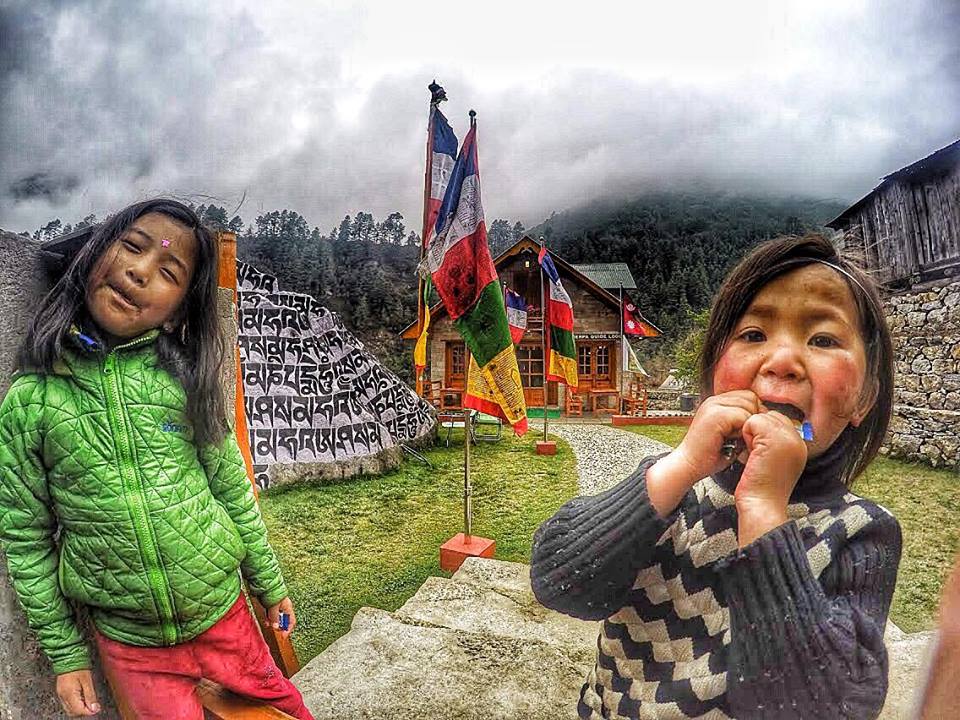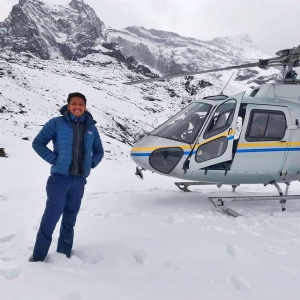Challenges of the Everest Base Camp Trek:
- High Altitude: The trek involves reaching high altitudes, with Everest Base Camp itself situated at over 5,000 meters (17,598 feet). Altitude sickness is a common challenge that trekkers may face, including symptoms such as headaches, nausea, and fatigue.
- Weather Conditions: The weather in the Himalayas can be unpredictable and harsh. Trekkers may encounter extreme cold, snow, and challenging conditions, especially during the winter and monsoon seasons.
- Physical Demands: The trek requires a good level of physical fitness. The steep ascents and descents, rocky terrain, and long hours of walking each day can be physically demanding.
- Remote Environment: The trek takes place in a remote and rugged environment. Access to medical facilities and other amenities is limited, and evacuation in case of emergencies can be challenging.
- Basic Accommodations: Tea houses along the route provide basic accommodations. Trekkers should be prepared for simple lodging facilities with shared amenities, and it's essential to adapt to the rustic conditions.
Rewards of the Everest Base Camp Trek:
- Breathtaking Scenery: The trek offers stunning panoramic views of some of the world's highest peaks, including Mount Everest, Lhotse, Nuptse, and Ama Dablam. The scenery is awe-inspiring and provides a sense of accomplishment.
- Cultural Immersion: Trekkers have the opportunity to immerse themselves in the unique Sherpa culture. Visiting monasteries, interacting with locals, and experiencing traditional rituals add a cultural dimension to the trek.
- Personal Achievement: Reaching Everest Base Camp is a significant personal achievement for many. The sense of accomplishment and the realization of standing at the base of the world's highest peak contribute to a memorable and rewarding experience.
- Adventure and Camaraderie: The trek is an adventurous journey that fosters camaraderie among trekkers. Facing challenges together, sharing stories, and supporting one another create lasting memories and friendships.
- Spiritual and Reflective Experience: The serene environment, Buddhist monasteries, and the sheer magnitude of the mountains create a spiritual and reflective atmosphere. Many trekkers find the experience to be not only physically rewarding but also spiritually enriching.
In summary, while the Everest Base Camp Trek poses challenges, the rewards, including breathtaking scenery, cultural experiences, personal achievement, and a sense of camaraderie, make it a truly unforgettable adventure for those who undertake it.
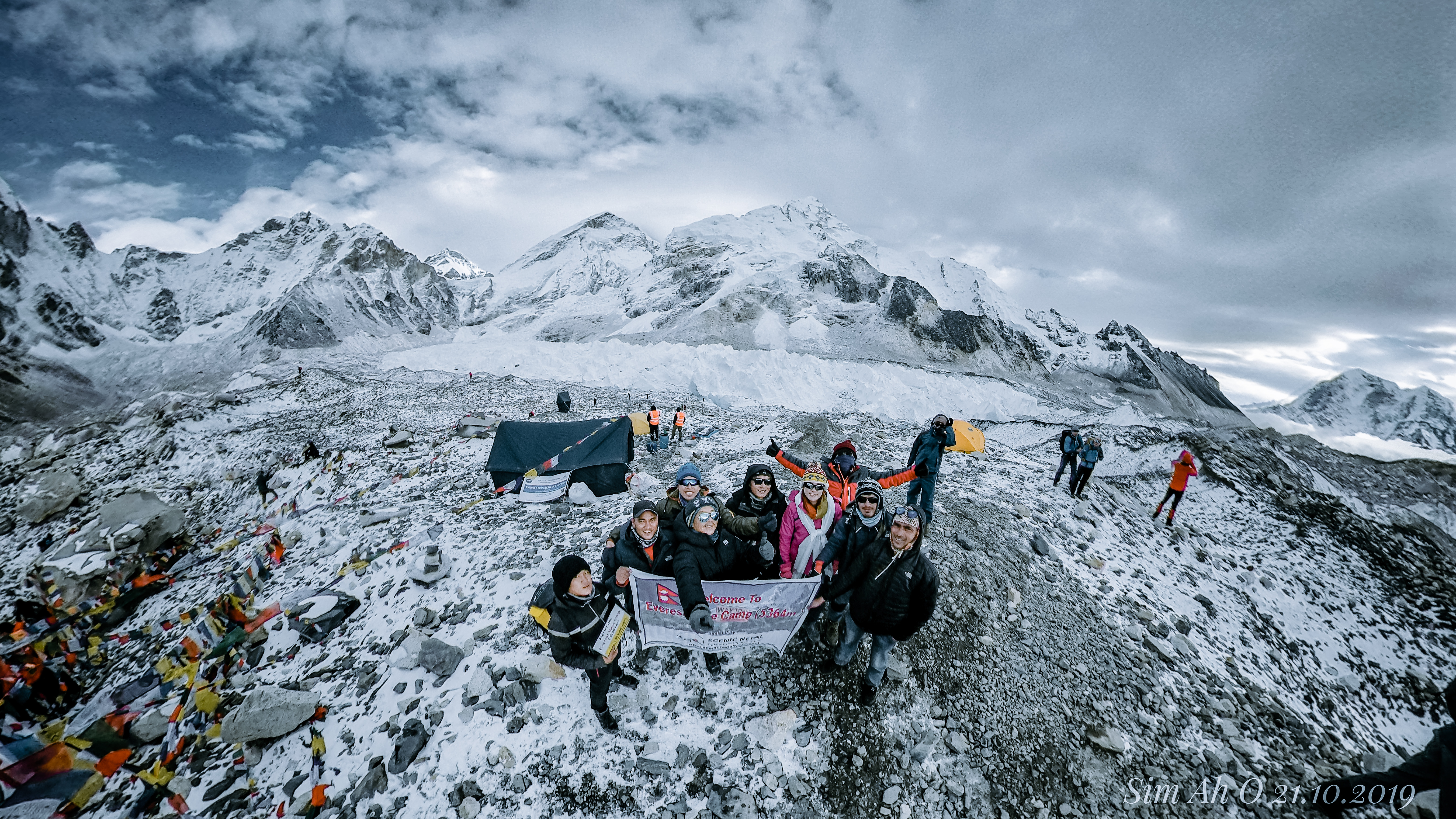
Physical Preparation:
- Cardiovascular Fitness for Everest Trek: Elevate your cardiovascular endurance through regular activities like running and brisk walking. Strengthening your heart and lungs is crucial for the sustained effort demanded by the trek.
- Strength Training Exercises: Incorporate leg, core, and upper body strength training exercises such as squats and lunges. Building muscle endurance is key to navigating the diverse terrains of the Everest region.
- Altitude Simulation Workouts: Simulate high-altitude conditions by training at higher elevations or using altitude masks. This prepares your body for reduced oxygen levels, a critical aspect of acclimatization.
- Endurance Building Hikes: Gradually increase the duration and intensity of your hikes, especially with a weighted backpack. This mirrors the long hours and variable terrain of the Everest Base Camp Trek.
- Flexibility Routines: Improve flexibility through stretching exercises, focusing on your legs, back, and shoulders. Flexibility reduces the risk of injuries on challenging trails.
Mental Preparation:
- Mindfulness and Meditation Techniques: Cultivate mental resilience through mindfulness and meditation practices. These techniques enhance focus and calmness, crucial for navigating the mental challenges of the trek.
- Visualization for Trek Success: Visualize successfully completing the trek to boost confidence and motivation. Positive visualization can empower your mindset for the journey ahead.
- Stress Management Strategies: Incorporate stress management techniques like deep breathing into your routine. Managing stress is vital for maintaining mental well-being during the ups and downs of the trek.
- Goal Setting for Each Trek Day: Set realistic goals for each day of the trek, breaking down the journey into achievable segments. This approach helps maintain motivation and a positive outlook.
- Education on Trek Challenges: Equip yourself with knowledge about potential challenges such as altitude sickness and weather fluctuations. Understanding what to expect mentally prepares you for unforeseen circumstances.
- Positive Affirmations for Mental Toughness: Boost mental resilience with positive affirmations. Remind yourself of your strengths and capabilities, fostering a positive and determined mindset.
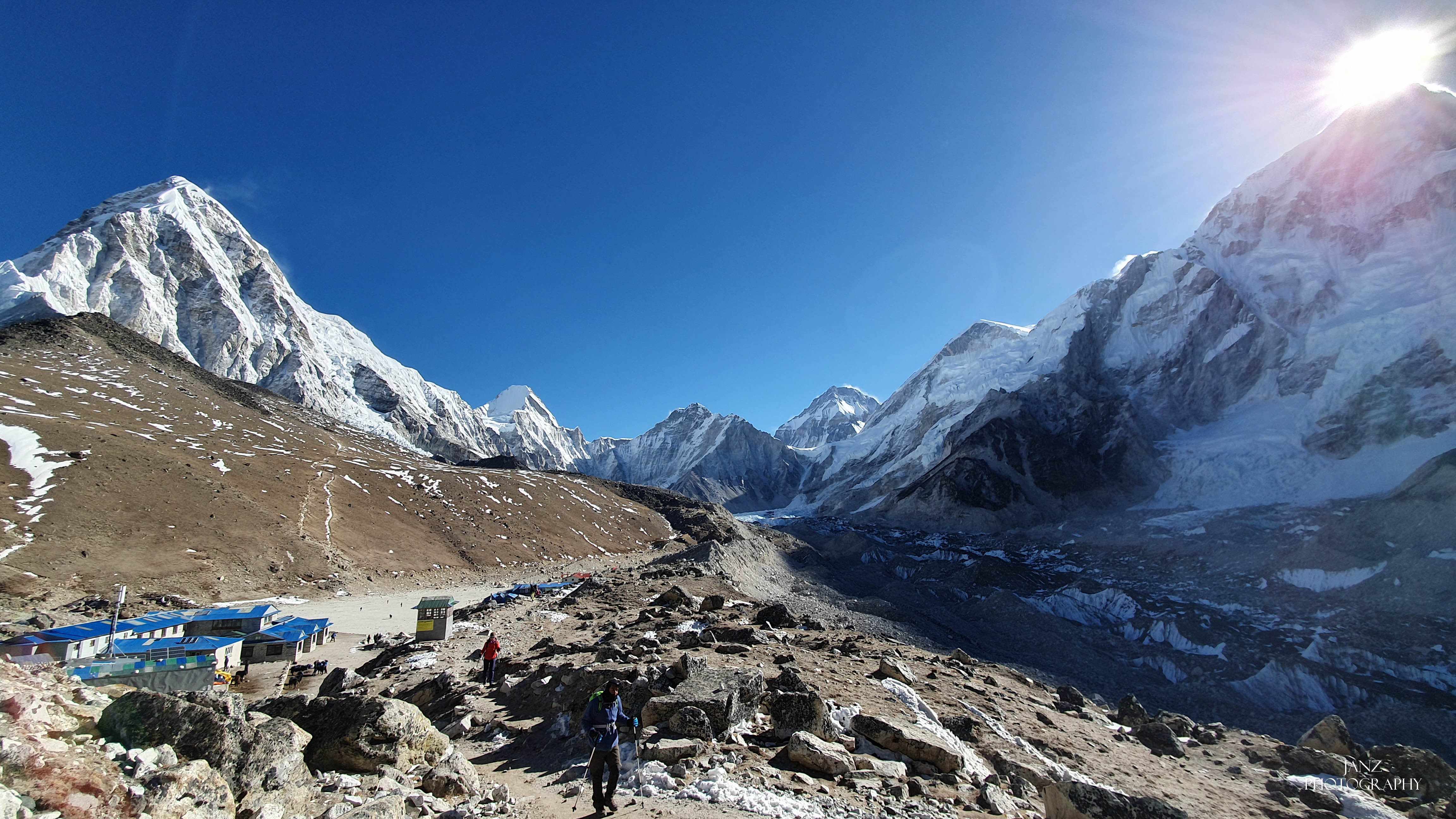
Altitude considerations:
Altitude considerationsare crucial when embarking on the Everest Base Camp trek due to the significant elevations involved. Proper understanding and preparation for the effects of high altitude can make the journey safer and more enjoyable. Here are key altitude considerations:
- Acclimatization: Acclimatization is the process of the body adjusting to the decreasing oxygen levels at higher altitudes. It is essential for preventing altitude sickness.The trek itinerary should include acclimatization days, allowing trekkers to rest at higher altitudes before ascending further. Common acclimatization stops include Namche Bazaar and Dingboche.
- Altitude Sickness:Altitude sickness, or acute mountain sickness (AMS), can occur when ascending too quickly. Symptoms include headaches, nausea, dizziness, and fatigue. Trekkers should be aware of the signs of AMS and inform their guides if they experience any symptoms. Descending to a lower altitude is the primary treatment for AMS.
- Hydration:Staying hydrated is crucial at high altitudes. The air is drier, and increased respiratory rate can lead to dehydration. Trekkers should drink plenty of fluids, avoiding excessive caffeine and alcohol consumption, which can contribute to dehydration.
- Pacing and Rest: A gradual ascent and a moderate pace are key to acclimatization. Rushing the trek increases the risk of altitude-related issues.Taking regular breaks and allowing the body to rest is important. Overexertion can lead to fatigue and increase the likelihood of altitude sickness.
- Altitude-Appropriate Clothing: Layered clothing is essential to adapt to the changing temperatures at different altitudes. Proper gear includes insulated jackets, moisture-wicking base layers, and waterproof outer layers. Protecting extremities with gloves, hats, and sunglasses is important, especially at higher elevations where UV radiation is stronger.
- Altitude-Related Medications: Consulting with a healthcare professional before the trek is advisable. Medications such as acetazolamide can help prevent and alleviate symptoms of altitude sickness. Trekkers should carry a basic medical kit, including medications for common ailments, as access to medical facilities is limited.
- Sleeping Altitude:Gradual sleeping altitude gain is crucial. Trekking to higher altitudes during the day and descending to lower altitudes for sleep helps with acclimatization.Trekkers should be mindful of sleeping elevations, especially as they approach higher points like Gorak Shep and Everest Base Camp.
- Emergency Preparedness:Understanding evacuation procedures and having a plan in case of severe altitude sickness is vital. Communication devices, such as satellite phones, can be essential for emergencies.
Packing Essentials
Packing for the Everest Base Camp trek requires careful consideration of the diverse and challenging conditions you'll encounter in the Himalayas. Here's a comprehensive list of packing essentials:
Clothing:
- Moisture-Wicking Base Layers: Long-sleeved tops and bottoms to manage sweat and maintain warmth.
- Insulating Layers: Fleece or down jackets for added warmth during colder temperatures.
- Waterproof and Windproof Jacket: A durable outer layer to protect against rain, snow, and wind.
- Convertible Hiking Pants: Lightweight and quick-drying pants that can be converted into shorts.
- Trekking Shirts: Lightweight, breathable shirts suitable for trekking.
Headwear:
- Sun hat, beanie, and buff or scarf for protection against the sun, wind, and cold.
Gloves:
- Waterproof and insulated gloves for warmth, especially at higher altitudes.
Undergarments:
- Moisture-wicking underwear suitable for trekking.
Hiking Socks:
- Thick, moisture-wicking socks to prevent blisters and keep feet warm.
Footwear:
- Sturdy Trekking Boots: Waterproof, well-insulated boots with ankle support for varied terrain.
- Camp Shoes: Lightweight and comfortable shoes for wearing around the lodges.
Gear and Accessories:
- Backpack: A comfortable and durable backpack with a capacity of at least 40 liters for carrying essentials.
- Sleeping Bag: Cold-weather sleeping bag suitable for temperatures encountered during the trek.
- Trekking Poles: Adjustable trekking poles for stability and support during descents and uneven terrain.
- Sunglasses: UV-protective sunglasses with side shields to shield eyes from intense mountain sun.
- Headlamp/Flashlight: Essential for navigating in the dark and power outages in lodges.
- Water Bottles and Water Purification: Insulated water bottles and a water purification system or tablets.
- Snacks: High-energy snacks like energy bars, nuts, and dried fruits for quick boosts.
- Camera: Lightweight and durable camera or smartphone for capturing the stunning landscapes.
- Power Bank: Portable charger to keep electronic devices charged.
Personal Items:
- Toiletries: Travel-sized toiletries, including toothbrush, toothpaste, and biodegradable soap.
- Quick-Dry Towel: Compact and quick-drying towel for personal hygiene.
- Personal Medications: Personal prescription medications and a basic first aid kit.
- Sunscreen and Lip Balm: High SPF sunscreen and lip balm to protect against strong mountain sun.
- Duct Tape: Handy for quick repairs on gear.
Documents:
- Passport with at least six months validity
- Trek Permits ( Scenic Nepal Treks prepare for you)
- Insurance:Travel insurance covering trekking and emergency evacuation.
- Nepal Visa. You can obtain on your arrival in Kathmandu. Click- ON ARRIVAL VISA
Miscellaneous:
- Journal and Pen:For documenting your journey and any important information.
- Trekking Map/Guidebook: A reliable map or guidebook for navigation and information about the trail. Scenic Nepal Treks will provide you Good Map.
- Trash Bags:To carry out any non-biodegradable waste and maintain the "Leave No Trace" principle.
Remember, packing light is essential, but ensuring you have the right gear for the challenging conditions of the Everest Base Camp trek is equally important. Tailor your packing list based on the specific season and weather conditions during your trek.
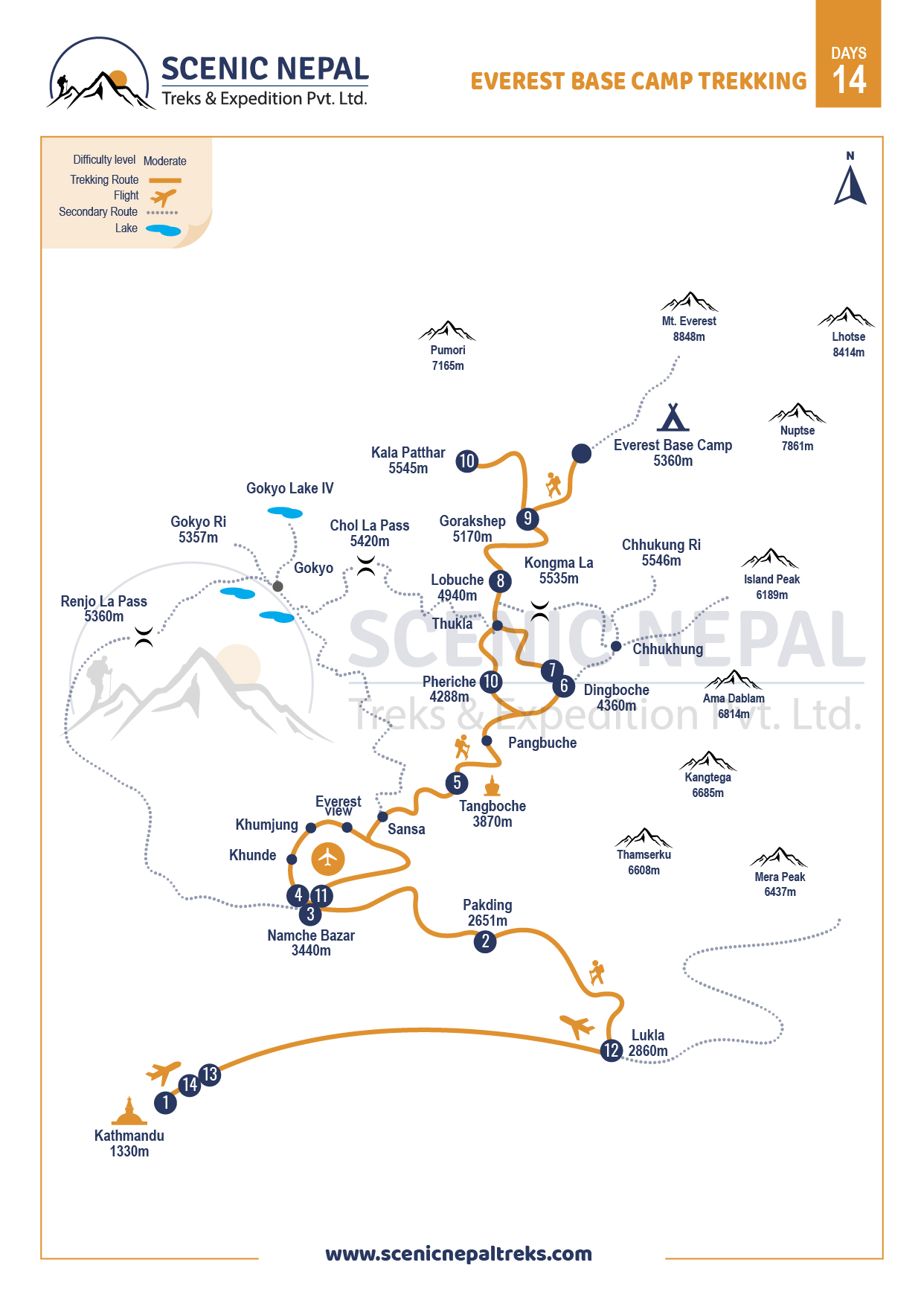
Common Trekking Itinerary
The best trekking itinerary to Everest Base Camp is one that allows for proper acclimatization, provides ample time to enjoy the stunning scenery, and minimizes the risk of altitude-related issues. Here's a well-balanced and popular itinerary for the Everest Base Camp trek:
Day 1:Your Arrival Kathmandu / Meet by Our representative at Kathmandu Airport Maximum Altitude1350 m / 4429.134 ft
Day 2:Early morning fly to Lukla, and trek to Phakding (2,651m/8,700ft): 8km, 3 - 4 hours trek
Day 3:Phakding to Namche Bazaar (3,438m/11,280 ft): 11km, 5 - 6 hours trek
Day 4:Acclimatization Day - Namche Bazaar: (3,440m/11,284ft)
Day 5:Namche Bazaar to Tengboche (3,870m/12,694ft): 10km, 5- 6 hours trek
Day 6:Tengboche to Dingboche (4,360 m/14,300 ft): 9km, 5 - 6 hours trek
Day 7:Acclimatization Day at Dingbouche / Explore Dingbouche Village
Day 8:Dingbouche to Lobuche (4940 m/16,207 ft): 4km, 2 - 4 hours trek
Day 9:Lobuche to Gorak Shep (5,170 m/16,961ft), visit Everest Base Camp (5,364 m/17,594 ft): 13km, 6-7 hours trek
Day 10:Gorak Shep to Kala Patthar (5,545m/18,192ft) to Pherice (4,288m/14,070ft): 16km, 7-8 hours trek
Day 11:Pheriche to Namche Bazaar (3,440m/11,280 ft): 20km, 6 - 7 hours trek
Day 12:Namche Bazaar to Lukla (2,860m/9,186ft): 19km, 6 - 7 hours trek
Day 13:Fly back to Kathmandu by Air (1,330m). 28 mins flight
Day 14:Transfer to the Airport for your onward destination / Farewell
Note: This itinerary allows for gradual acclimatization and includes rest days at critical points. It provides trekkers with an opportunity to adapt to the high altitude, reducing the risk of altitude sickness. Keep in mind that weather conditions, flight availability, and individual fitness levels may influence the actual trekking days and schedule. Always follow the guidance of experienced guides and trekking agencies to ensure a safe and enjoyable experience. Check our 15 Days Everest Base Camp Trek .
Hydration and Nutrition:
Embarking on the Everest Base Camp trek requires not just physical endurance but also a well-planned approach to hydration and nutrition. Elevate your trekking experience with these tips for staying nourished and hydrated in the challenging Himalayan environment.
Hydration Essentials:
- Water is Your Best Friend: Stay well-hydrated to combat the effects of high altitude. Aim for a minimum of 3-4 liters of water per day. Carry a durable, insulated water bottle and consider using a hydration system to ensure easy access while trekking.
- Purify Your Water: Use water purification tablets or a reliable water filter to ensure that the water you consume is safe and free from contaminants. Hydrating with clean water is crucial for preventing waterborne illnesses during the trek.
- Balance Water with Electrolytes: As you ascend to higher altitudes, you may lose more electrolytes through increased respiration. Replenish electrolytes with sports drinks or electrolyte supplements.
- Start Early, Drink Often: Begin your day with a glass of water and make a conscious effort to drink consistently throughout the day. Hydrate before you feel thirsty, as thirst may not be as noticeable at higher elevations.
Nutrition Strategies:
- Fuel with Carbohydrates: Carbohydrates are your main energy source. Prioritize complex carbohydrates such as oats, whole grains, and rice for sustained energy. Consume energy-rich snacks like granola bars and trail mix during the trek.
- Include Lean Proteins: Protein is essential for muscle repair and recovery. Include lean protein sources like lentils, beans, and nuts in your meals.Opt for local protein-rich dishes in teahouses for a taste of the region's cuisine.
- Healthy Fats for Sustained Energy: Incorporate healthy fats such as nuts, seeds, and avocados for sustained energy during the trek. Trail mix with nuts and dried fruits is a convenient and nutritious snack option.
- Moderate Portion Sizes: Adjust portion sizes to match your activity level. Overeating can lead to discomfort, especially at higher altitudes where digestion may be slower.
- Stay Consistent with Meals: Maintain a consistent eating schedule. Regular meals provide a steady source of energy and help regulate blood sugar levels. Don't skip meals, and include a mix of carbohydrates, proteins, and fats in each meal.
- Local Cuisine Exploration: Enjoy the local cuisine for a taste of Sherpa culture. Dishes like dal bhat (lentil soup with rice) provide a well-balanced combination of nutrients. Introduce variety into your diet with local fruits and vegetables available along the trail.

Accommodation on Everest Base Camp Trek
Accommodations on the Everest Base Camp trek primarily consist of tea houses, also known as trekking lodges. These establishments are scattered along the trail, providing essential shelter, meals, and a chance to rest for trekkers. Here's what you can expect in terms of accommodation during the Everest Base Camp trek:
Tea Houses:
- Tea houses are the predominant form of accommodation along the trekking route to Everest Base Camp.
- These lodges are typically run by local Sherpa families, offering a unique opportunity for cultural exchange.
Room Options:
- Tea houses offer a range of room options, from basic dormitories with shared facilities to private rooms with either shared or attached bathrooms.
- Room availability may vary, and during peak trekking seasons, it's advisable to book in advance.
Basic Amenities:
- Accommodations are basic but comfortable, with essential amenities such as a bed, blankets, and pillows.
- Some tea houses may provide extra blankets to combat the cold at higher altitudes.
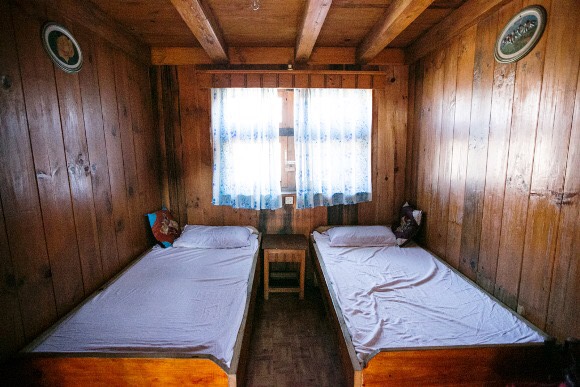
Communal Areas:
- Common areas in tea houses serve as social hubs where trekkers can relax, socialize, and share experiences.
- Communal dining spaces are where trekkers enjoy hearty meals, often served family-style.
Heating:
- At higher elevations, tea houses may have wood-burning stoves in common areas for warmth.
- Bedding is designed to keep you warm, but it's advisable to bring a good sleeping bag suitable for colder temperatures.

Meals:
- Tea houses offer a variety of meals, typically a mix of local and international cuisine.
- Popular choices include dal bhat (lentil soup with rice), noodles, soups, and a variety of snacks.
Hot Showers and Charging Facilities:
- Some tea houses offer hot shower facilities, but they may come with an additional cost.
- Charging facilities for electronic devices are available in common areas, often powered by solar energy.
Sustainability Practices:
- Many tea houses are adopting eco-friendly practices, such as waste management and energy conservation, to promote sustainable tourism.
Trekking Permits and Accommodation Booking:
- For certain trekking permits, you may need to provide proof of pre-booked accommodations for specific nights.
- Trekking agencies typically handle these reservations, ensuring a smooth journey.
High-Altitude Considerations:
- Accommodations are strategically located at varying altitudes to facilitate proper acclimatization.
- During acclimatization days, staying at a higher altitude and then descending to sleep at a lower altitude is a common practice.
Safety Measures
Embarking on the Everest Base Camp trek is an exhilarating adventure, but prioritizing safety is paramount in the challenging Himalayan terrain. Here's a comprehensive guide to essential safety measures, ensuring a secure and memorable journey to the roof of the world.
Trusted Trekking Agencies:
- Choose a reputable trekking agency with a track record of safety and experienced guides.
- Ensure the agency complies with safety standards and has a commitment to responsible trekking practices.
Experienced Guides:
- Opt for experienced guides who are well-versed in the Everest region's trails and challenges.
- Seasoned guides enhance safety by providing valuable insights, managing risks, and responding effectively to emergencies.
Acclimatization Protocol:
- Follow a thoughtfully designed itinerary that includes acclimatization days at key elevations.
- Gradual acclimatization minimizes the risk of altitude sickness and allows the body to adjust to lower oxygen levels.
Weather Monitoring:
- Stay informed about weather conditions along the trekking route.
- Plan your daily itinerary based on weather forecasts, and be prepared for sudden weather changes in the high-altitude environment.
Emergency Evacuation Plan:
- Familiarize yourself with the emergency evacuation procedures provided by your trekking agency.
- Carry a reliable communication device, such as a satellite phone, to facilitate swift communication in case of emergencies.
Altitude Sickness Awareness:
- Educate yourself and fellow trekkers about the symptoms of altitude sickness.
- Prioritize health over reaching set goals, and communicate any discomfort or symptoms to your guide promptly.
Comprehensive Travel Insurance:
- Secure comprehensive travel insurance that specifically covers high-altitude trekking.
- Ensure the policy includes provisions for medical emergencies, evacuation, and potential trip cancellations.
Appropriate Gear and Equipment:
- Invest in high-quality trekking gear suitable for the Everest region's demanding conditions.
- Adequate clothing, sturdy boots, and reliable equipment contribute to your safety and comfort.
Regular Communication:
- Maintain open communication with your guide and fellow trekkers throughout the journey. - Regular check-ins help assess the group's well-being and allow for quick response to any emerging issues.
Tips to avoid altitude sickness
Avoiding altitude sickness is crucial for a successful trek to Everest Base Camp. Here are several tips to help prevent altitude sickness and ensure a safe and enjoyable journey:
Gradual Acclimatization:
- Follow a well-designed trekking itinerary that includes gradual acclimatization days at higher elevations.
- Ascend slowly, allowing your body to adjust to the reduced oxygen levels at higher altitudes.
Stay Hydrated:
- Drink plenty of water to stay well-hydrated, aiming for at least 3-4 liters per day.
- Avoid alcohol and caffeine, as they can contribute to dehydration.
Balanced Nutrition:
- Maintain a balanced diet with an emphasis on carbohydrates for energy.
- Include foods rich in iron and antioxidants, such as fruits and vegetables, to support overall health.
Avoid Overexertion:
- Pace yourself and avoid overexertion, especially in the initial days of the trek.
- Listen to your body and take breaks as needed.
Medications:
- Consult with a healthcare professional before the trek and discuss the possibility of taking acetazolamide (Diamox) to help prevent altitude sickness.
- Carry any prescribed medications and inform your guide about your medical history.
Monitor Symptoms:
- Be vigilant for early signs of altitude sickness, including headache, nausea, dizziness, and fatigue.
- Communicate any symptoms promptly to your guide and consider descending if symptoms persist.
Adequate Sleep:
- Ensure you get enough restful sleep, especially at higher elevations.
- Adequate sleep contributes to overall well-being and helps the body acclimatize.
Avoid Alcohol, Sex and Smoking:
- Refrain from alcohol consumption, Sex and smoking at higher altitudes, as these can exacerbate the effects of altitude sickness.
Choose the Right Route:
- Opt for well-established trekking routes with gradual ascents and proper acclimatization days.
- Well-planned itineraries, like those provided by reputable trekking agencies, minimize the risk of altitude sickness.
Stay Warm:
- Dress in layers to stay warm, especially during cold nights and early mornings. - Cold temperatures can increase the risk of altitude-related issues, so proper insulation is crucial.
Hydrate with Warm Fluids:
- In colder temperatures, consider drinking warm fluids to stay hydrated. - Warm liquids can be more appealing than cold ones, encouraging you to maintain fluid intake.
Local Remedies:
- Try local remedies such as drinking hot ginger lemon tea, which is believed to help with acclimatization and digestion.
Prioritize Safety Over Goals:
- Prioritize your health over reaching specific trekking goals. - If you experience severe symptoms of altitude sickness, be prepared to descend to lower altitudes.
Remember that everyone reacts differently to high altitudes, and factors such as age, fitness level, and individual susceptibility can influence how well you acclimatize. Pay attention to your body, communicate openly with your guide, and take necessary precautions to minimize the risk of altitude sickness during your trek to Everest Base Camp.
Embarking on the Everest Base Camp trek is not just a physical feat; it's a symphony of preparedness, resilience, and the indomitable spirit of adventure. As the final steps lead to the revered base of Mount Everest, let's revisit the crucial tips that have paved the way for an unforgettable odyssey.
